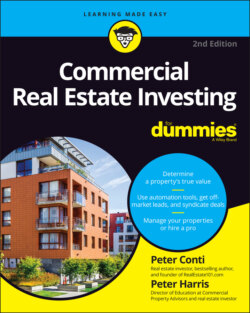Читать книгу Commercial Real Estate Investing For Dummies - Peter Harris - Страница 75
Navigating Too Many Deals
ОглавлениеTo get a handle on wholesaling, imagine that you’re the vice president in charge of acquisitions for a large commercial real estate investment fund. Your job is to sort through the hundreds of deals that your team of deal finders feed you each week from across the country. Your deal finders are experienced pros who know how to find motivated sellers, connect with them directly, and get signed purchase contracts at below market prices or with creative financing terms.
What you’re going to do is to sort through the signed contracts you’ve been sent to separate out any deals that don’t fit your ideal requirements. Your fund has grown to where it only makes sense to do larger properties, so you put any signed contracts with less than 50 units into a folder on your computer labeled “Wholesale Deals.”
Another quick sort through the remaining properties based on your current acquisition guidelines allows you to eliminate a few more properties that have greater than 20-percent vacancy, are located in a metropolitan area with less than 200,000 in population, or properties built before 1978 when lead-based paint was still in use.
These properties are added to the others in the Wholesale Deals folder. Similar to a worker at the fruit packing plant, you’re sorting through the deals coming in to pull the ripest, juiciest, fruit off the conveyor belt because your fund “cherry picks” the best deals to ensure strong returns to its investors.
Using your experience along with some software and automation, you’re then able to perform initial underwriting for each deal using industry averages and market rents from each area to provide you with the projected cash on cash return. The strongest deals, those with the least risk and the highest returns, stay on your desk. Everything else goes into the Wholesale Deals folder.
This goes on throughout the week until Friday, when you open up the Wholesale Deals folder to take a look at everything in there. These are the deals that didn’t make the cut for your big investment fund, but you know there’s still some value here. Your job is to take these deals, which may be highly desirable to smaller investment companies or individual investors, and wholesale them off.
You run these wholesale deals through another analysis, which eliminates any properties that are too risky or have low returns that would make them unattractive to an investor or buyer. Because these don’t make sense for any buyer to move ahead, the contracts on these will be cancelled (which is allowed during the due diligence period).
Make sure that any properties you plan to wholesale have “some meat left on the bone.” If you discover that your purchase price is so high that after adding your fee an investor won’t have any room left to profit, then drop out of the deal so you’re not tying up a seller’s property, which isn’t going to work as a wholesale deal. The remaining deals are divided into two subfolders: One folder (the very best deals) is for your VIP buyers, while the other (still very good deals) is for the public.
The very best of these are initially emailed out to your VIP buyers list, people whom you know and have done business with previously. After three or four days, your buyers have scooped up most of these. Anything that’s left is added to the properties in the other subfolder, which you then market as wholesale opportunities to the public.
Since you probably don’t work for a big investment fund, here’s how to use this same concept: Get commercial properties under contact and then wholesale them to other investors. You may have heard of investors wholesaling single family homes to an end buyer to make money. Figure 4-1 illustrates this process.
FIGURE 4-1: The Commercial Wholesaling Process.
